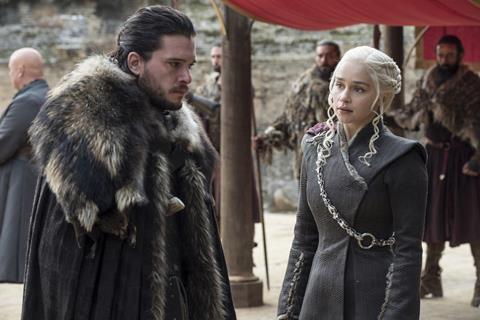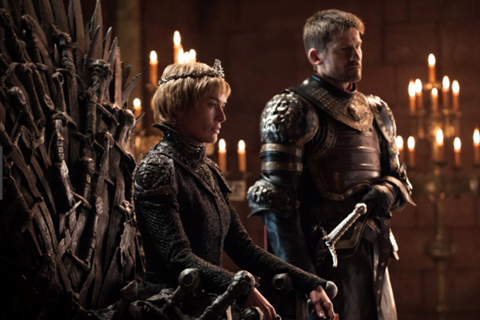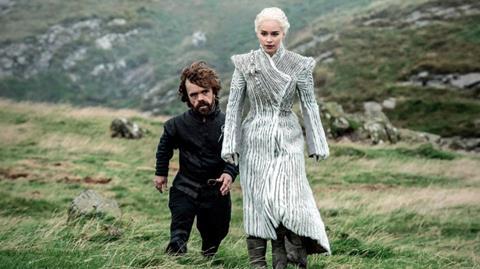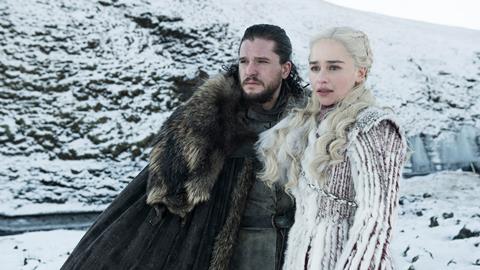Ahead of the final season of Game of Thrones premiering on Sunday (14 April), Adrian Pennington looks at the huge security operation to prevent it from being pirated and previews the epic battle scenes and visual effects that lie at the heart of the franchise finale.

You can close the betting now. Outlasting every pretender for the right to rule, the winner from Emmys to BAFTA in 2020 will be a Westeros lock-out.
Already the most Emmy garlanded drama show in history, the insanely popular TV franchise is valued by some analysts at north of $1 billion. Naturally, the season’s end game has been closely guarded but even the most ironclad measures are unlikely to prevent it from being the most pirated series ever.
Four episodes of season five popped up on pirate sites before official transmission and another set were hijacked in 2017.
“Your filming dates are on a need to know basis. You don’t get hard copies of scripts anymore. They are all on this special app. Which are triple locked.” Joe Dempsie, actor, Game of Thrones
IP Echelon (now owned by Vobile), the Australian anti-piracy company used by HBO for season seven, monitored torrents and issued thousands of warning letters to ISPs but that didn’t prevent over a billion illegal streams, according to monitoring firm Muso.
Even the cast during filming of season eight had to learn their lines from firewall protected iPads, not printed scripts.
According to Joe Dempsie (who plays Gendry) the security extended to any information about shooting. “During the whole course of season seven and season eight I have never laid eyes on a shooting schedule,” he told The Express, “Your filming dates are on a need to know basis. You don’t get hard copies of scripts anymore. They are all on this special app. Which are triple locked.”
Secrecy was amped up even further for the sixth and definitively final episode, helmed by showrunners David Benioff (also a writer on sci-fi feature Gemini Man) and Daniel Weiss.
Filming was so top secret that only crew members wearing a special Episode six badge were allowed on set with some scenes even shot on a closed set.
Battle for Winterfell
The one aspect of the production that has been allowed to be publicised is designed to guild the show’s epic narrative.
Each of the final six episodes reportedly cost in excess of $10 million and aside from S8 episode one’s tame 54 minutes run time, episodes three-six are super-sized, clocking in at a feature length 80 minutes.
Among these will be an immense battle decider at Winterfell which will take up most of an entire episode. Indeed, the episode’s director Miguel Sapochnik, says the aim was to outdo the record 40-minute long Helm’s Deep siege in Lord of the Rings: The Two Towers.
“I find the best battle sequences are when you have a strong point of view. I keep thinking: ‘Whose story am I telling right now?’” Miguel Sapochnik, director, Game of Thrones
He says he studied Peter Jackson’s film to determine when the audience would get “battle fatigue” from too much hacking and slashing.
“It feels like the only way to really approach it properly is take every sequence and ask yourself: ‘Why would I care to keep watching?’” the British director told Entertainment Weekly, “One thing I found is the less action — the less fighting — you can have in a sequence, the better.”
This battle to end all battles is the final face-off between the Army of the Dead and the army of the living where heroes including Jon Snow (Kit Harington), Daenerys Targaryen (Emilia Clarke), Tyrion Lannister (Peter Dinklage), Arya Stark (Maisie Williams), Sansa Stark (Sophie Turner), and Brienne of Tarth (Gwendoline Christie) all join forces.

“The [GoT battles] I’ve done previously [‘Hardhome’ and the Emmy-winning ‘Battle of the Bastards’] were generally from Jon’s perspective,” Sapochnik explains. “Here I’ve got 20-some cast members and everyone would like it to be their scene. That’s complicated because I find the best battle sequences are when you have a strong point of view. I keep thinking: ‘Whose story am I telling right now?’”
The episode required 11 weeks of night shoots, apparently exhausting to cast and crew. Sapochnik wanted to shoot continuously in one location rather than split the shoot over time and into multiple green screen segments which is common for creating action scenes in blockbuster movies.
The producers agreed. “When you have rapid cutting you can tell it was all assembled in post-production,” Benioff says. “That’s not the show’s style and it’s not Miguel’s style.”
“What we have asked the production team and crew to do this year truly has never been done in television or in a movie,” co-executive producer Bryan Cogman told EW. “This is completely unprecedented and relentless and a mixture of genres even within the battle. There are sequences built within sequences built within sequences. David and Dan [wrote] an amazing puzzle and Miguel came in and took it apart and put it together again. It’s been exhausting but I think it will blow everybody away.”
Epic VFX, epic campaign
Successive seasons have gone from conversational scenes in relatively low budget studio sets, to increasingly monumental VFX-extended location shoots with legions of white walkers and plenty of dragon time.
The VFX work load is now comparable to that of a Marvel film with facilities in Canada, UK and New Zealand landing significant creature or environmental shot orders from supervisor Joe Bauer including Rhythm & Hues, Rodeo FX, Method Studios, The Third Floor, Image Engine, Weta Digital, Pixomondo, Zoic and Dublin’s Screen Scene (which is owned by NEP).
All of this hyped secrecy cleverly adds to the multi-million dollar marketing campaign building to episode one which airs globally on April 14.
HBO’s orchestration included hiding six Iron Thrones around the world for fans to find, a team up with American Red Cross for a blood drive campaign called Bleed For The Throne and tasking artists to re-imagine 18 props from the show.
Sky (now Comcast)-owned streaming service NOW TV gave fans the chance to receive Game of Thrones themed tattoos. All of this was promoted on Facebook. Even the fountain in front of Las Vegas casino Bellagio has been turned into a light and sound stunt.
This is nothing new. In December 2017 Belfast International Airport was temporarily re-named as Westeros Airport.
GoT Production Halo
Northern Ireland is arguably the main beneficiary of the series success, even more so than HBO which under new parent AT&T must now seek to fill the hole left in its schedule.

In the decade since HBO shot the pilot in Belfast to the final day of filming in September 2018, it is no understatement to say that the film and TV industry in NI has been revolutionised.
Previously renowned for documentaries and with no history of large drama productions, the region has been transformed.
“It is no secret that we hope Game of Thrones will do for Northern Ireland what Peter Jackson’s Lord of the Rings did for New Zealand,” states local film and TV trade and funding body NI Screen. “With a much longer shelf life than the majority of films and an expanding worldwide reach and penetration, Game of Thrones has real potential as a driver of tourism. It is possible that the series will deliver the widest media exposure Northern Ireland has ever received outside of politics and the troubles.”
Belfast’s Titanic Studios (including main GoT stage the Paint Hall) and Harbour Studios are among the largest soundstages in the UK.
“The level of investor confidence required to build these multi-million pound stages could only have been achieved through such a cinematic television project as GoT and its potential to provide stable work flow for a number of years,” insists NI Screen.
The GoT halo has raised the profile, skill levels and work load of location scouts to costume designers across Northern Ireland.
The estimated value of HBO’s investment to the region by 2017 alone was £206 million – not a bad return on just £16m in NI funds.
That doesn’t include a potential ‘prequel’ to the Westeros saga (working title The Long Night) being shot by HBO as a pilot at the Paint Hall from source material by GoT author George R.R. Martin and filmmaker Jane Goldman (Kick-Ass).
“Our hope and expectation is that HBO will remain in Northern Ireland for many years yet,” says Richard Williams, CEO at NI Screen told Broadcast,
“Arguably the most significant change lies in the perception and credibility of Northern Ireland, in London and particularly in LA.”
From being Northern Ireland’s first major foreign drama production in 2009 GoT has propelled the region to the A league. NI Screen expects to host three even four major projects to invest there between now and 2022.
HBO has fuelled demand for GoT by keeping distribution off competing SVODs like Netflix and Amazon and even clamping down on second hand sales of past series DVD collections on Amazon’s retail site. Exclusivity of series eight (alongside distribution on long standing partner platforms like Sky), plus the Jane Goldman-penned sequel and potentially three other fantasy series at various stage of development will drive the launch of AT&T’s WarnerMedia SVOD label later this year.
While GoT characters slug it out over the next few weeks, HBO’s longer term battle for the small screen has only just begun.

























No comments yet